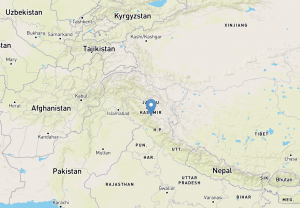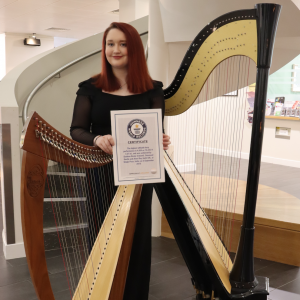Camac Blog
Siobhan Brady and the Highest Harp Project: harping above the clouds
News
September 18, 2023
Back in 2018, we dubbed Siobhan Brady the ‘world’s loftiest harper’. This moniker is fun, but also well-earned. Guinness World Records declared that, during her concert in the Himalayas (in aid of Cystic Fibrosis Ireland), the harp was played at higher altitude than ever before. This was at 4954 m (16,253 ft 3.37 inches), on September 6th 2018, at Singla Pass in India. Siobhan recalled that “For the concert in the Himalayas, I was invited onto the team by Desmond Gentle only a few months before we flew out, so a lot of the organising and behind the scenes aspects were already sorted.”
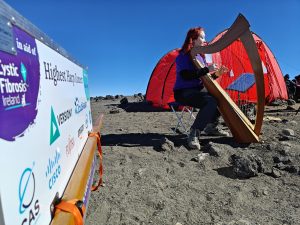
Siobhan Brady performs at the summit of Kilimanjaro.
Having achieved this momentous feat, one might forgive Siobhan for resting on her laurels, however “Desmond had wanted to recreate this idea on Mt. Kilimanjaro and raise even more money for Cystic Fibrosis. Sadly, after his return to London he passed away. My Dad and I decided to fulfil this dream in his memory”
And so began a quest to beat her own record, with everything resting on Siobhan and her father Sean in terms of planning: “We had to find enthusiastic team members, sponsors and mountain guides. It took about two years of hard work for everything to come together but in the end, the team of 19 we gathered honestly became like family.”
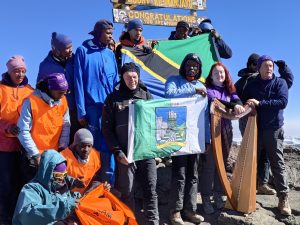
The Highest Harp team, understandably jubilant at the summit of Kilimanjaro
After these years of hard work, in July 2023 the team set off for Tanzania to make their attempt. Naturally, with Siobhan as an existing record-holder, and reckoning with the magisterial Kilimanjaro, the project received a great deal of interest: “We have had quite the reception to this adventure! I wasn’t expecting any of it at all. Upon landing in Kilimanjaro Airport, they had national news cameras waiting and a dance troop of the local university performing for us. Before we departed for the hike we had a special welcome party at Machame Gate. The Irish Ambassador for Tanzania Mary O’Neill and, Tanzania’s Permanent Secretary of Natural Resources and Tourism, Hassan Abbas, gave speeches for us live on national TV […] On our descent we were congratulated the president of Tanzania, Samia Suluhu Hassan.’
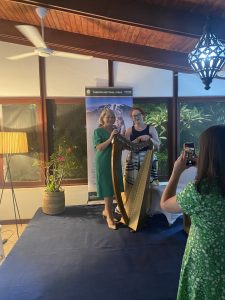
While the previous project was at an altitude of just under 5000 meters, Kilimanjaro is almost 6000 meters, and those extra meters bring a new level of difficulty: “We knew it would be a very tough climb but telling that to yourself is different to experiencing it. Personally, I had the privilege of training a lot in an amazing altitude gym in Dublin called Altipeak, and they gave me a tent to sleep in that simulated altitude as well as a machine that connected to a mask so I could practice the harp under those conditions for weeks before I flew out.
We also had the amazing Caroline Heffernan, (who has Cystic Fibrosis) with us, and she taught us breathing techniques over the course of two years. When you are in a situation where you are getting reduced oxygen, the important thing is not to panic.”
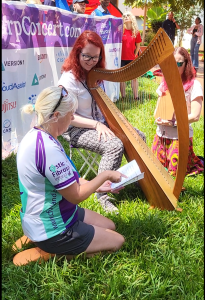
Siobhan Brady with team-member, Caroline Hefferman.
Naturally, the ever transferrable skill of the musician played its part here: “It reminded me of a lecturer from college who got students to run up flights of stairs and then play their repertoire, so they practised playing replicating stage fright.”
While the training and mental preparation were essential, it seems that the presence of a highly bonded team was the key asset on this climb:
“The team that I had with me were so amazing, we were laughing and singing all the way up the mountain […] we had our happiest times at meal times and kept everyone’s spirits high, as you never knew which team members were struggling. On day four, our photographer, Stephen Lappin, made the decision to return to the base. The whole team was devastated but we did understand it was for the best. Climbers die on Mount Kilimanjaro every year because they don’t turn back when they have to.”
As Siobhan and the team began the final approach to the hostility of the environment inevitably became more and more evident: “The summit climb was probably the hardest day for most of the team. We were woken at 11pm and began walking at midnight […] Everyone felt the altitude worst here. Several people saw hallucinations during the walk, headaches, vomiting, stumbling and body shakes are very common. At 6am we saw the beautiful sight of sunrise which meant we would feel the heat from the sun soon. We reached the summit (5,895 meters) at 8am.”
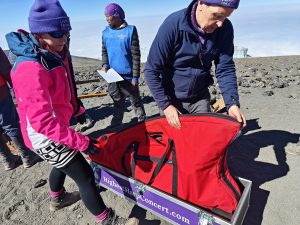
Not only had Siobhan arrived in great shape, mercifully the harp did too! Siobhan recalls: “We took the harp [a Camac Janet] out of the custom flight box and it was in perfect tune! […] Every musician knows the anxiety of travelling with their instrument as it could get lost or even damaged. Kilimanjaro has 5 different climates […] In the space of five days we went from a hot, humid rainforest to standing on a glacier. Camac thankfully had sent us spare strings and levers but we didn’t need any! Which was great from a safety point of view, as we needed to spend as little time on the summit as possible.”
At last able to play the longed-for concert in an unparalleled environment, it seems that the physical and emotional ordeals were worth it: “The concert at the summit felt like the most amazing dream. It didn’t feel real at all . The clouds were so far below us and a glacier behind me, it was a beautiful view. I got to open the concert with Caroline Heffernan reading a poem by the Irish president Michael D Higgins. This was quite an emotional moment as no one was sure if Caroline would make it to the summit at all [due to her condition].”
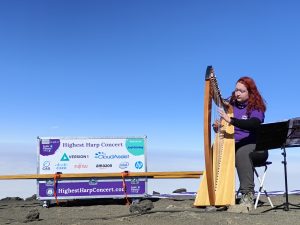
Siobhan in concert at the summit of Kilimanjaro
Siobhan’s personal highlight was performing Ed Sheeran’s song “Little Bird” (arranged by Rory Moloney), played in memory of Triona Priestley: “In 2014 there was a campaign for Ed Sheeran to get in touch with Triona who had Cystic Fibrosis. When she was in the hospital, Ed rang the phone and sang her favourite song for her.” As it turns out, young Triona made her final transition during Sheeran’s performance. “I included this song to honour Triona, but also every person who had lost their fight to Cystic Fibrosis. This charity is so deserving of help and support and I am honoured to be able to raise vital funds.”
Predictably, Siobhan still hasn’t quite managed to halt her efforts: “We brought a cameraman with us on the hike with the intention of turning this story into a documentary. I am currently working hard of turning that dream into a reality. That involves filming interviews and working production companies, editors and directors. It is a very exciting opportunity to experience the film industry and I never thought it is something that could happen from the harp!”

